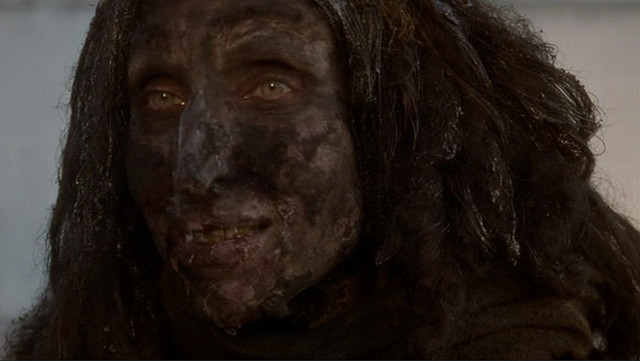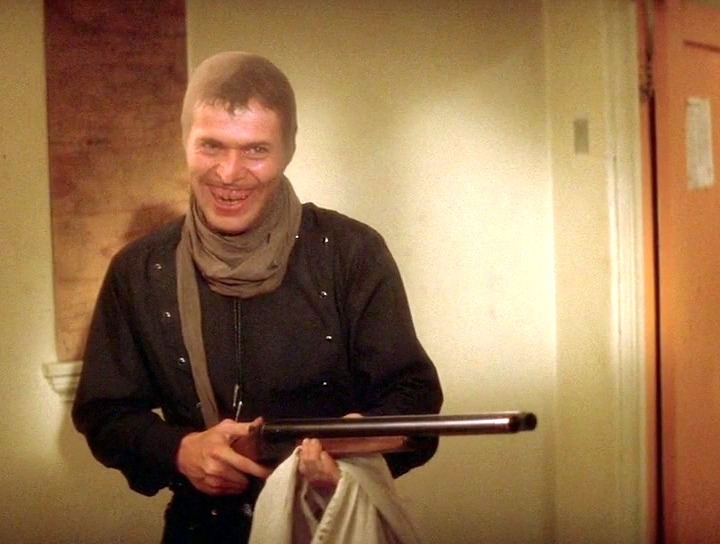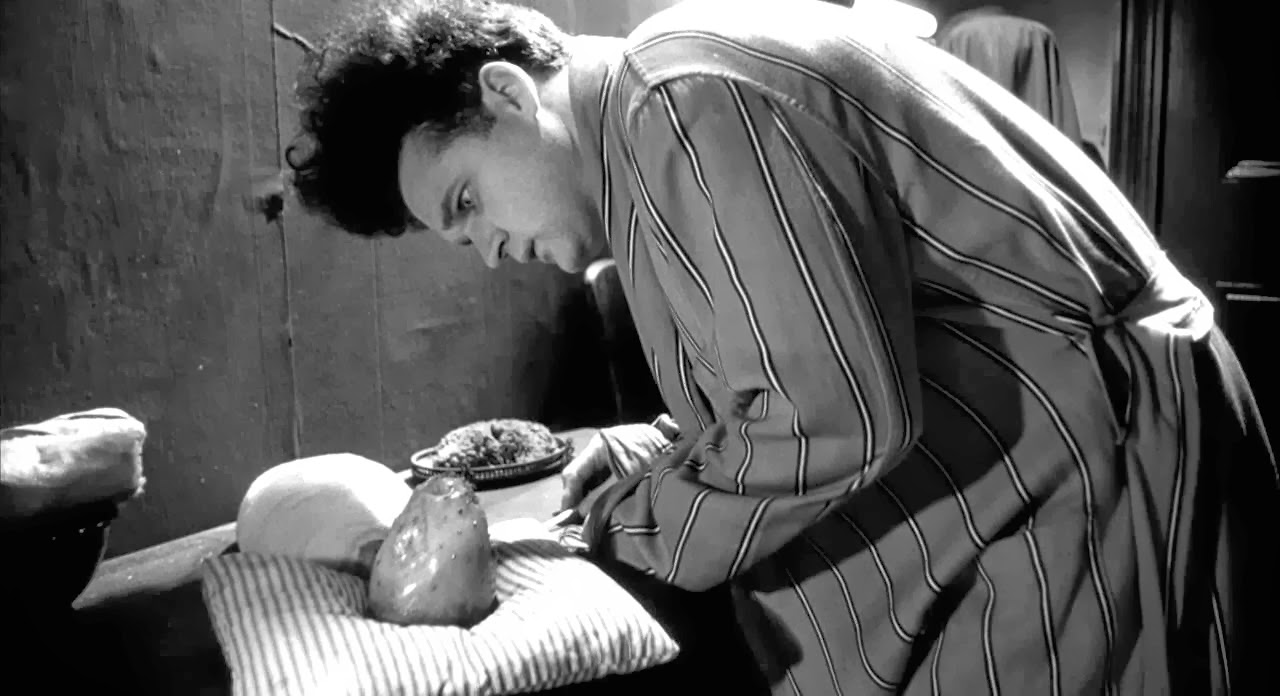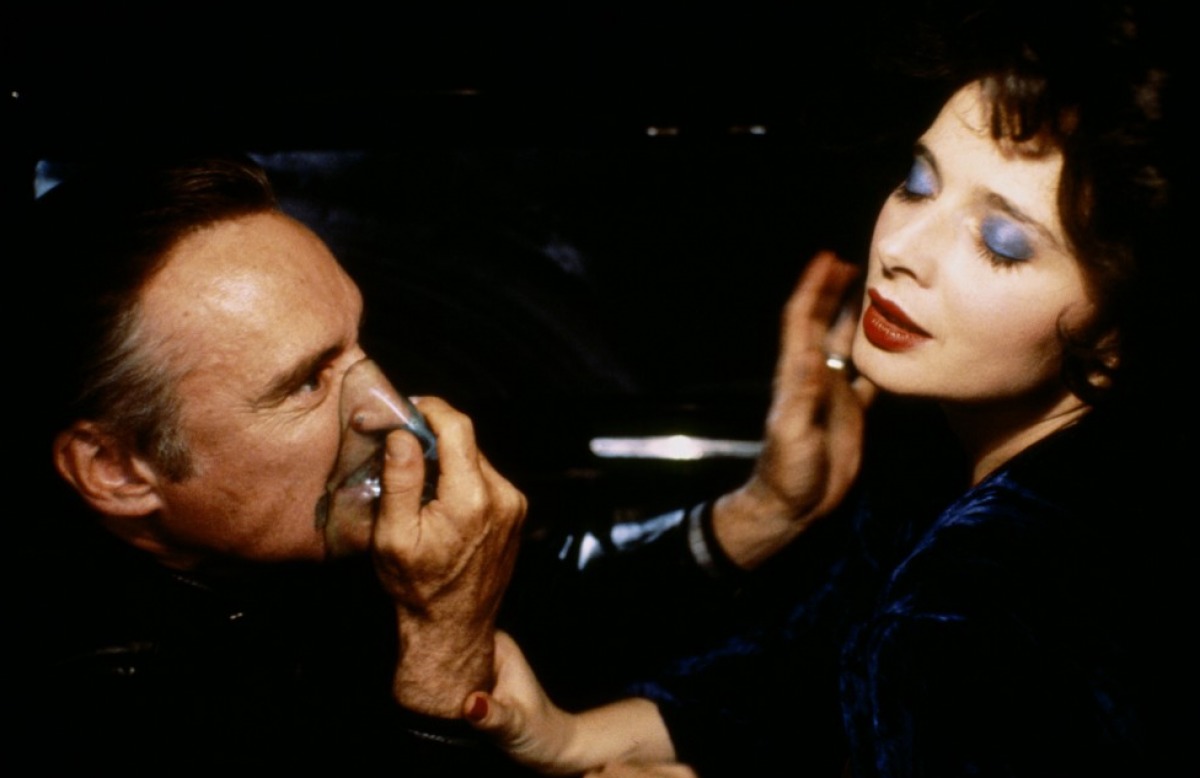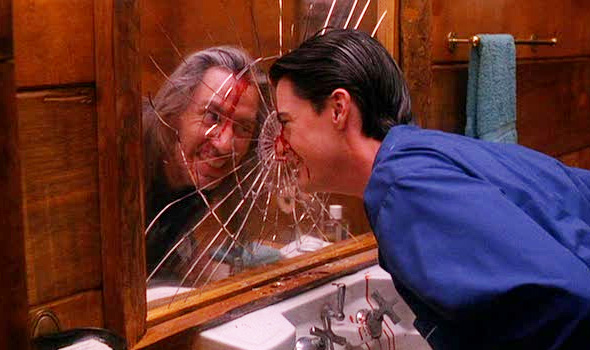5. Mulholland Drive (2001): The Homeless Figure Behind the Dumpster
No one knows what this figure really is, but it’s not too hard to figure out what he/she/it represents. This character lives inside a dream, it is dirty and unkempt, and has a slight twinkle of evil and menace behind it’s eyes. It scares the bejesus out of L.A.’s most skittish inhabitants seemingly just to entertain itself, and is quietly lurking behind every corner so it can jump out and remind every struggling wannabe it comes across in Hollywood of the same thing: this is the reality that awaits you at the end of your dreams.
Not an easy feat to say the least, this “character” from Mulholland Drive is one of the most terrifying villains on this list because it serves as more of a vague (and haunting) notion that it does as a clearly defined character. That’s a very large part of what makes it, and Mulholland Drive itself, such a unique and horrifying representation of the lost and broken dreams contained within a fractured, delusional, and painfully disillusioned mind.
4. Wild At Heart (1990): Bobby Peru (played by Willem Dafoe)
Willem Dafoe’s portrayal of Bobby Peru is one of the most gleefully twisted, perverse, disgusting, funny, and downright disturbing entries on this list. Dafoe and Lynch are a true match made in heaven, and it’s a wonder the collaboration didn’t happen sooner (and perhaps more so, that it hasn’t happened again since).
Peru embodies everything we have come to expect from a David Lynch film. He is sexually alluring at one glace, menacing at a second, and physically disgusting/nauseating at a third (the character has some pretty severe dental issues).
He takes pride and glee in the pain and humiliation he brings into his victims’ lives (he takes his time in sexually humiliating Laura Dern’s character just to provide the punch line to his own sick joke) and shows no sign or capability of empathy, remorse, or soul. He is, to quote Dern’s character, a true “black angel”: sadistic, cruel, and perversely, sickly entertaining.
3. Eraserhead (1977): The Baby
Another clever cheat? Perhaps. The “baby” in Eraserhead is not an outright villain, no, but it is a fairly clear representation of some unquestionably antagonistic and terrifying emotions. Premature and disfigured to the point of not even resembling a human being (Lynch will carry the secret of what the baby was actually made out of to his grave), the baby in Eraserhead is, simply put, the embodiment of a thoroughly nightmarish prison.
The lead character in Eraserhead, Henry Spencer (played irreplaceably by late Lynch regular Jack Nance), is trapped inside a living, waking nightmare because of the baby’s entry into his life. He is kept awake, night after night, listening to the wails of the mutated creature, unable to escape, unable to find relief, unable to even dream.
Mentally and physically, Henry is imprisoned by the new addition to his life (which cackles with sadistic glee when it sees it’s father sexually humiliated by his neighbor across the hall). Lynch’s intention with this monstrous creation is disturbingly clear as he turns one of the most common themes of everyday adult life into one of the most unsettling and uniquely terrifying: responsibility.
2. Blue Velvet (1986): Frank Booth (played by Dennis Hopper)
The late, great Dennis Hopper came back from the brink of career extinction in 1986 with his Oscar-nominated performance in Hoosiers and his near-universally renowned turn as the sadomasochistic baddie from Blue Velvet, Frank Booth.
In his portrayal of Booth, Hopper pushed the boundaries of his emotions with a character so depraved, violent, sickly obsessed, and perversely unreal that you didn’t know whether to laugh, cry, or cower at his displays of sadistic, almost artistically-focused debauchery (many, many viewers can’t help but do all three when first introduced to the character.)
Frank Booth is misogyny embodied. He is the “disease” Isabella Rossellini is always enigmatically whispering about to Kyle MacLachlan. He is a representation of sadism, sexual irresponsibility and carelessness, masculinized sexual violence, and the self-loathing that always feeds and births all of it from the beginning. His one, brief glimpse of humanity is in a single, sad moment where he watches Rosselini sing onstage and silently cries while cradling a small cloth of, you guessed it, blue velvet).
In Hopper’s portrayal of Frank Booth, we as an audience see the first time Lynch truly let himself go as a filmmaker. The frenzied mess of psychotic, sexually confused, woman-destroying behavior that is Frank Booth is something that, before it, was unmatched and, even by today’s jaded standards, is still extraordinarily shocking, raw, and eternally unforgettable.
1. Twin Peaks (1990): Killer Bob (played by Frank Silva)
Exemplified both intermittently in the television series and a bit more thoroughly in the feature film that followed it (1992’s Twin Peaks: Fire Walk With Me), there’s nothing much scarier, on film or in reality, than seeing Killer Bob (played with a ferocity and commitment by the late Frank Silva) having a good time.
When he’s having fun, Killer Bob laughs with frequency and often does it backwards (don’t ask, just watch) while also doing very unfunny things (they usually involve murdering young women). Killer Bob’s laughter makes you feel like every sense of security you’ve ever had in your life is being mocked by the embodiment of pure evil. There is no getting away from him. He has always been there. He will always be there. Nothing can escape being corrupted by his possession.
Like the homeless figure in Mulholland Drive (though far more thoroughly explored in the world of Twin Peaks), Killer Bob makes more sense as a concept, as an idea representing something, than he does a full-fledged or obtainable character.
The extent to which he is tangible (is he a spirit that truly possesses those he inhabits or is he merely a construct of their fractured mental state?) is almost trivial to discuss, because it ultimately doesn’t matter what he is, particularly in David Lynch’s mind or in the world of Twin Peaks.
To quote Miguel Ferrar’s character, Albert Rosenfeld, in season two of the show, Bob is “the evil that men do.” He is the voice in Leland’s (always beautifully played by Ray Wise) head that makes him rape and murder his own daughter. He is the force that guides the hand behind every regrettable, evil, violent act… And, like most of the worst/best villains in Lynch’s work, he not only thrives on it, he is thrilled by it, aroused by it, and enjoys every sadistic, terrifying minute of it.
There’s no humor in Killer Bob, and there is no entertainment to be found in seeing his evil acts. He is a truly terrifying creation that no other villain in any work by David Lynch has ever, or probably will ever, come close to duplicating again.
Author Bio: Matt Hendricks is an independent filmmaker with several projects currently in development.
